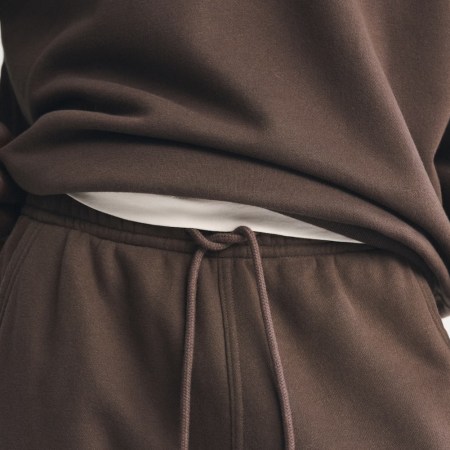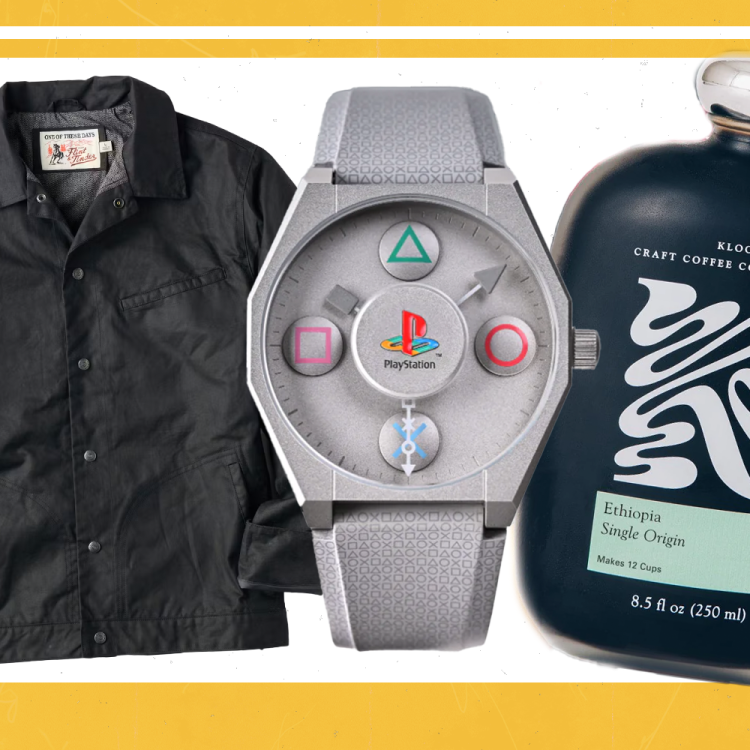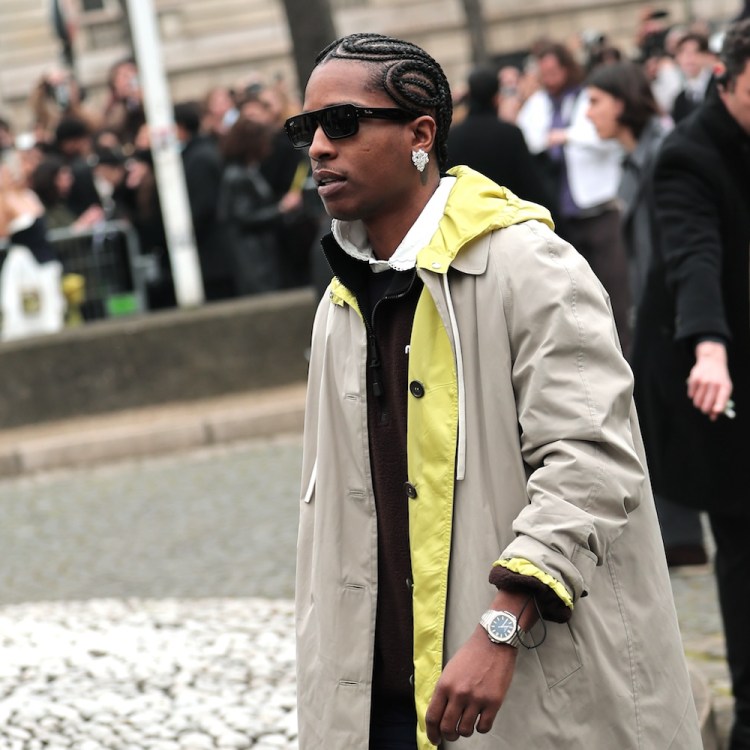When The Good Fight entered its sixth season this year, it did so without one notable character: Adrien Boseman, played by the indomitable Delroy Lindo. Boseman was, among many things, one of television’s most well-dressed men; in his perfectly tailored three-piece suits that only a man of Lindo’s bravado could pull off, his onscreen presence was a feast for the senses. But fear not, as The Good Fight remains one of the most well-costumed shows on television, thanks to Dan Lawson, who also was the creative genius behind the costume design on The Good Wife.
Despite Boseman’s absence, the menswear on the show remains noteworthy — a true feat considering the monotonous way lawyers often dress. (I would know, I went to law school.) Despite the sea of suits on The Good Fight set, no one’s clothing feels staid and no one fades into the background. Every detail, seam and hem feels intentional without feeling inauthentic. It feels like fiction, not fantasy; a legal fashion utopia that real-world lawyers should aspire to.
We had the chance to catch up with Lawson to pay tribute to the dapper Adrien Boseman, and to talk about everything from tie knots to tailoring on the set of the hit series.
InsideHook We can’t talk about the menswear on The Good Fight without talking about Adrian Boseman played by the incomparable Delroy Lindo. Tell me a little bit about how you developed the wardrobe for his character.
Dan Lawson: He’s smart, he’s clever, he’s handsome, all of that stuff, but he is a showman. I love the idea of three-piece suits. It just immediately came to me. He’s 6’2 or 6’3, he’s a nice, tall guy, broad shoulders. I was lucky to have a really good canvas to start painting with and he’s bald and he makes such a striking image. And I love that about him.
I wanted suits that had stronger shoulders. I wanted to play up his height and support that with the broad shoulders. And there were a couple things that Delroy really wanted, things that were very important to him. He really wanted a wider leg in the trousers and that’s because his legs are so long and he didn’t want to look like he had little spindly legs coming out. Of course, the style was to have slimmer trousers, so he and I had a nice negotiation about that and where we were going to land with the width of his trouser leg.
And then he kind of caught into the idea when we brought up the trousers to a more modern length, he loved the idea of introducing really bright socks. Bright, colorful, patterned socks. And he would feature them on camera. He’d make a point of pulling up his pant leg as he sat down to show off his socks. I love when you work with an actor who is as excited about their look and their clothing as I am and someone who is so collaborative about it and who wants to evolve with you, so that’s always exciting for me. So he ended up with very bright-colored socks.
And oh, he always wore suspenders. And we never saw that underneath his vests, but we always made sure that they coordinated so that he felt good about it. Sort of like what I call the inner costume.
Oh, I love that: the inner costume.
It’s just a sort of psychological for the actor. He knows this matches this matches this, everything matches going down, or goes together in a way. Even if it’s not supposed to go together, we know that we’ve created a look consciously and he walks out confident about that.
Those little details are so critical.
He always let me tie his ties, which, I love that. His collars were a little more spread and I liked having that spread filled in with a nice, big, juicy knot and if you ask just about any actor I’ve worked with in New York, they’ll be like, “Oh yeah, Dan Lawson, he’s a double Windsor.” It’s true.
Menswear can become quite repetitive. A dark suit, a white shirt, a tie. A dark suit, a white shirt, a tie. And it’s all of the little elements that you pay attention to as a designer that suddenly you take 10 little elements and put them together and you’ve got a unique person now in front of you, a unique look. And I do think menswear is challenging in that sense. Men’s business wear is challenging in that sense and there’s certain uniforms in the world that you have to abide by, like the Wall Street uniform. And trying to create character delineation and a unique personality, it’s hard. It’s really hard and it’s fun to mine all of those little details.
It was important to use to really create a showman, but someone who would be taken seriously. It’s a fine line to walk. You don’t want to go too far.
Michael Sheen’s character on the show, Roland Blum, immediately comes to mind as someone who goes too far — but intentionally.
We wanted that bravado and he’s putting it out there and he’s always bigger than life and you look at him and you’re like, “Oh my god, Holy Mackerel, what’s going on?” But that’s what we wanted for him.
I actually went to Suitsupply for him because Suitsupply had these wonderful suits in stock; I could custom-build a bunch of suits for him through Suitsupply. And they just had all the bells and whistles that I really loved for that character. When we were doing the fitting with Michael, I remember, he was like, “Yes, yes.” He’s the guy who puts on the stuff and looks in the mirror for a while and thinks about it and moves as the actor and does all that, which I love when actors do that.
They’re coming into a show that’s already up and running and they’ve gotten the script at midnight the night before and they’re coming in. They’re trying to figure out the character and when they come in and they work with the costume designer who is very collaborative and wants to discuss the character with them and what’s going to make them feel right, actors love that. And they love getting the hints and little nods to who that character is as we’re building it and putting it together in the fitting room, and I love that. I really do.

The juxtaposition of him against Adrian, even in their tailoring, was so striking and illustrative to me.
I made the stand on [Blum’s] shirt a little higher than normal so it’s just more present, you see more of the collar, it’s just more in your face, which is what he is. Now, I do want to point out, quite often on The Good Fight and previously on The Good Wife, [the creators of the show] Robert and Michelle do not like to hit the end of a sentence with an exclamation mark. And so I will often dress against character as it’s written so that I’m not underscoring. We had the character Elsbeth Tascioni on The Good Wife and Good Fight and she’s kind of a nut, but we didn’t want to dress her in that way. But with Roland Blum, we really wanted to go head on with it and make it as big as… his curly hair and the personality he was playing.
I think somebody who is in distinct contrast to both Adrian Boseman and Roland Blum is how we dress Julius on the show.
Yes, please — let’s chat Julius [Cain], who’s dressed so simply most of the time. But he never looks unmatched with the more styled characters.
He is so conservative and so careful about his wardrobe and the spread on his shirts are not too wide, they’re not too narrow. The way that Michael Boatman plays Julius – he’s a conservative Republican Trump supporter and all that, to have him dressed very conservatively actually did make him stand out in a good way amongst a world of lots of men in suits.
I work with Martin Greenfield Clothiers out in Bushwick in Brooklyn and I design the suits and they build them for Michael Boatman and they did it for me for Delroy, as well. And it’s everything from the width of the lapel, how much the jacket comes in at the waist, how much rope you have at the shoulder. Michael Boatman’s suits, I like him to have an extra little … because he’s so conservative in his look, I want him to have a little more presence than what a regular suit would have, so they add a little extra rope here in the shoulder. A little bit. So if you look at him in silhouette, it’s like a nice, smooth, and then there’s a little speed bump.

And we have some new faces this season as well, like Wayne Brady.
He knows clothes like nothing. I remember I was in my first fitting and we got talking about sneakers and I said, “What type of sneakers would you like?” And I was totally prepared to hear Adidas or Nike and he’s like, “Oh, Belmont or YSL does a really great sneaker that’s got a capped toe and patent leather,” and so I was like, he really knows what he’s talking about. He knows what he likes and what he doesn’t like and so it was really interesting to work with him in the fitting room and create a character. The whole thing with him is we didn’t want him to look like a lawyer, but at times, he needed to look professional.
Wayne wanted super slim pants, like super slim. I say “Okay, here are your pair of pants. They are really skinny.” And he’s like, “These will be fine.” And he would put them on and be like, “Oh yeah, they’re great.”
We went to brands like YSL, and we had a suit and we loved it. It was a black and white Prince of Wales plaid and we found the last one in America and the jacket wasn’t quite the right size and one of my assistants dug and dug and dug and we finally found one in Paris that they could send us in the right size and it was the last one in the world. I’m like, “Come on. In the world?” And they’re like, “Yes, it’s the last one in the world.” It’s like, “Oh my gosh.”
And his character has a real sex appeal to him.
Sexy is such a double-edged sword because sexy is what we see. You can see something and assess it, but sexy is so also about how the person feels in what they’re wearing and doing. They feel sexy and alluring and that was something that was really challenging and exciting to work with with Wayne about, him feeling a certain way wearing business wear and then it sort of evolves into more on-set jeans and blazers, that sort of thing.
You know who also has such an easy sex appeal to him, is Kurt.
Ever since he started on Good Wife, I had this Southwestern piece of jewelry, a belt buckle. He wears it all the time. It’s nickel silver and it’s got turquoise and coral and stuff in it and it looks so Southwestern Native American. I love it so much. That’s mine. When I was in sixth grade, my dad had a business associate over at the house and he was wearing that and I guess I must have gone on and on about how much I loved this belt and he took off his belt and he took it off and he gave it to me. He also wore my suede Ralph Lauren jacket.
Speaking of suede, can we talk about Jay, because he’s got a collection of suede jackets that anyone would envy.
The whole thing when we started with Jay was I didn’t want him to look like a lawyer. Not even close. But he has to be able to blend in and be taken seriously and so I was like, “I think he wears a tie, but I think I don’t want him to wear a suit jacket. I want to use a suede jacket or a more casual jacket as a substitute for a suit jacket,” and then he’ll often wear jeans, but still with a tie or pattern-on-pattern and color. He definitely has more color than some of the other guys with their look. He doesn’t wear a proper dress shoe.
Again, I just wanted there to be something that set him apart and something that you were talking about, which made me think, “Oh yeah, well, of course these people all look like they belong.” We’ve created a show, a look on the show, where there is no template. We talked a little bit earlier about the Wall Street uniform. We don’t have that, so if somebody dresses in a unique way in our world that we’ve created on The Good Fight, they’re going to look like they belong because everybody else is also walking around in their own delineated, unique, personal style.

What was it like dressing Mandy Pantinkin?
We were deep in COVID when he started and the first time we saw him he had the judge’s robe on and we’re like, that’s all I need is height and suit size and I got the judge’s robe squared away. Then Mandy and I decided, let’s get together when we really need to have a fitting. And we’re like, “Great,” and he just kept being like, “T-shirts and jeans and denim.” That’s where we ended up and so he’s one of my all-time favorite Broadway actors. I can’t even say how much I love him.
And then there’s his sort of partner in crime, David Cord.
He is a lawyer, but he’s not. He’s a businessman who is also a lawyer and he was just like, “I don’t want to look like a lawyer,” and we wanted that really kind of laid back, easy-breezy … one of his weapons is that you like him and then he goes in for the jugular, so that’s what we wanted. So we put him in things like cords and suedes and tweeds and so many of his ties are woolen, wooly ties and shirts that have some color or some pattern to them, just anything to make you like him, make you want to be with him.
And of course we really can’t talk about going for the jugular without getting some insight on David Lee.
When I first started, he always wore brown suits. Mushy-toned suits with mushy-toned shirts with mushy ties and I don’t know what the word for this is, but in my mind, the gesture for him was in the corner wringing his hands, plotting. And that’s just what I wanted his clothes to feel like. And then on Good Fight he was sort of way up in the firm in the very first episode of the first season of the series and I had him in darker and more white shirts and a little more toeing the line, if you will, back to what you and I were talking about: the uniform. And now that he is the STR Laurie rep who all of our lawyers answered to, we decided that the whole STR Laurie, everybody who works up there, they’re just in the uniform.
So he has really gone through a major transition throughout the 12 years. Very slow, very subtle, but now he’s there and it’s been really exciting to do that with him, to take the actor on that trip with his wardrobe.
This article appeared in an InsideHook newsletter. Sign up for free to get more on travel, wellness, style, drinking, and culture.

























